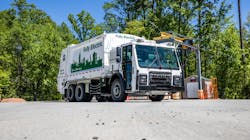As electrification creeps into the commercial vehicle sector, more fleets will be able to unlock the power of regenerative braking, which, when active, uses the onboard electric motors to slow down the truck. This shifts the load from the foundation brakes to reduce wear and tear, and generates electric energy for the battery to extend range.
While any electric vehicle (EV) can take advantage of regenerative braking, those that often stop and start, particularly garbage trucks, may benefit the most.
“Garbage trucks eat brakes, in general, with the start and stop application that it is,” explained Scott Barraclough, Mack Trucks senior product manager for e-mobility. “It’s a 50-yard dash 800 to 1,000 times a day. They go through brakes pretty quickly.”
This is a main reason refuse fleets such as Republic Services and the City of New York Department of Sanitation have piloted Mack’s LR Electric battery-electric refuse trucks.
“There’s very ample opportunity to recapture the kinetic energy from the vehicle moving,” Barraclough said. This could be as much as 20% energy returned.
Regen does not add any new components to the braking system, though the driver may need to adjust the settings, which are software controlled. It activates simply when the driver takes his or her foot off the accelerator.
“As soon as the truck sees zero throttle, it starts to apply the regenerative braking, just like it would the compression brake on a diesel engine,” Barraclough explained.
The LR Electric has three settings: low, high, and automatic for higher speeds where a driver may want to coast to a stop.
“The automatic setting does what’s called blended braking,” Barraclough said. “So, it doesn’t come on until you depress the brake pedal and blends the regen braking with the foundation brakes.” Drivers should pick up the nuances in short order, he said.
Mack does not yet have enough data to definitively say how much brake life will be saved but the OEM expects “substantial improvements.”
On the long-haul side, Penske Transportation Solutions found electric trucks that first returned with 7 to 8% charge were coming back with up to 15% due to learning how to work the regenerative braking system better, according to Drew Cullen, senior vice president of fuels and facility services at Penske. In the future, as regenerative braking gains trust and validation, government regulations may be rewritten to account for the extra stopping power. This could allow brake manufacturers to decrease component weight.
“We skinny up the air disc brakes and make them even smaller if we can rely on regen,” said Joseph Kay, Meritor director of engineering, brakes. “There are some hurdles, but it’ll happen eventually where they start allowing combinations of braking
About the Author
John Hitch
Editor
John Hitch is the editor-in-chief of Fleet Maintenance, providing maintenance management and technicians with the the latest information on the tools and strategies to keep their fleets' commercial vehicles moving. He is based out of Cleveland, Ohio, and was previously senior editor for FleetOwner. He previously wrote about manufacturing and advanced technology for IndustryWeek and New Equipment Digest.

